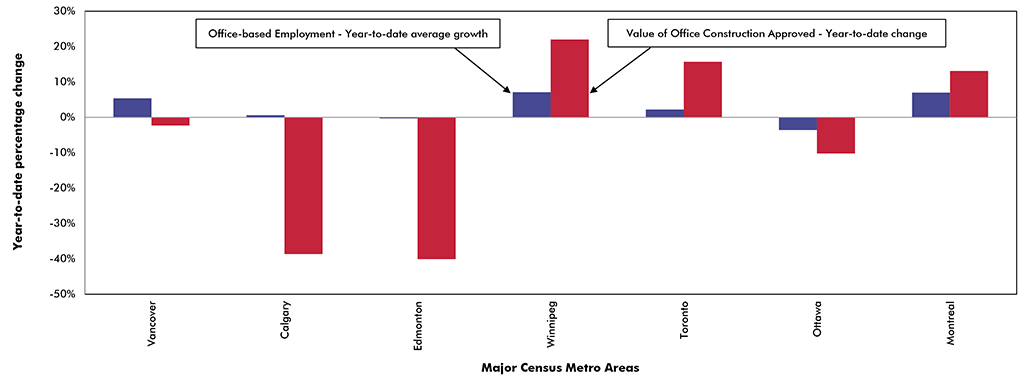Before zeroing in on Canada’s office market, it is useful to gauge the status of the country’s overall investment climate. According to the Bank of Canada’s (BoC) most recent Business Outlook Survey, the investment plans of firms cooled further in the third quarter of this year after hitting a seven-year high in the first quarter.
However, despite this retreat, the net percentage of firms planning to invest (+17) remained above their historical average of +13.7. This above-average outlook for total investment was reinforced by a sharp improvement of investor confidence reflected by the close to 1000-point jump in the S&P/TSX since early September.
Also, fuelled in part by a 9.9% gain in the third quarter, after-tax corporate profits are up by 22% year to date. This is their strongest showing since 2010. Finally, the recently announced corporate tax cuts in the U.S. should have a positive impact on Canadian exporters given that it makes no mention of a border adjustment tax.
Consistent with the moderating pattern of investment intentions reported by the Bank of Canada, a number of recent 2018 forecasts, including the OECD’s, are calling for economic growth in Canada to downshift somewhat following an unsustainably strong showing in 2017. However, despite this prospect for an easing in the pace of overall economic activity, the fundamental drivers of demand for commercial office space appear to be relatively strong in most of the country’s largest census metro areas.
Starting on the west coast, the Vancouver office market is very hot. This strength stems in large part from strong year-to-date growth of office-based employment and a very small increase in the supply of new office space. According to Cushman Wakefield, the overall office vacancy rate for the city of Vancouver hit a nine-year low of 6.5% in the third quarter, the lowest among Canada’s eleven largest census metro areas. Given limited new supply and the recent expansion plans of Amazon and Facebook, we expect demand for office space to cause vacancy rates to tighten further next year.
In the wake the 2014 oil price collapse there are signs that the gradual firming in energy prices since mid-2016 is having a positive impact on the Calgary economy and contributing to a stabilization in demand for commercial office space. This improvement is reflected by the sustained year-over-year growth of full-time employment since the beginning of 2017. Although office-based employment in Calgary has exhibited negligible growth year-to-date, the CMA’s office vacancy rate has declined slightly from 21.4% in Q2/2017 to 20.8% in Q3/2017.
Higher energy prices are also having a positive impact on the Edmonton commercial office market. Fuelled by stronger year-over-year growth of office-based employment, the office vacancy rate in the provincial capital edged lower from 16.8% to 16.4% over the past six months due to the absorption of over 80,000 square feet of vacant space. Given the evidence of improving business confidence and the prospect of firming oil prices due in part to the recent extension of OPEC production cuts, demand for office space in both Calgary and Edmonton should gradually strengthen through 2018.
Given that Toronto is Canada’s fastest growing census metro area it is not surprising that demand for office space is exceptionally strong. Driven by gains in hiring of the professional, scientific and technical services industry and in financial services, growth of office-based employment has averaged 2.2% over the past twelve months. Despite additions to the inventory of available space in both the central and suburban areas, the vacancy rate in the Central Area dropped to a record low of 3% in Q3/2017 while in the Suburban Area it stood at 11%, down from 11.6% in Q1/2017.
The prospect for sustained growth of office-based employment, coupled with extremely low vacancy rates in Toronto’s Central Area, should maintain upward pressure on rents and contribute to a migration of renters seeking more affordable office space in the suburbs.
The fact that Montreal’s office vacancy has remained above 12% since Q4/2015, (it’s currently at 13.7% and above the national average of 11.5%) suggests that the metro area’s office market is lagging behind both Toronto and Vancouver.
However, given that office-based employment was up by 8.5% y/y in November (the largest y/y gain among the eight largest census metro areas) the outlook for new office construction in Canada’s second largest metro area is quite positive.
This prospect is reinforced by a $395 million (13.1%) year-to- date increase in the value of approved office construction projects. Looking further ahead, Montreal’s attractiveness for further investment in new office construction should be enhanced by construction of the new light rail system which will operate four train lines in the metro area.
Office-based Employment vs Value of Office Construction Approvals











Recent Comments
comments for this post are closed